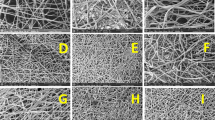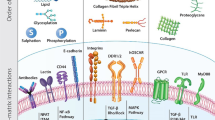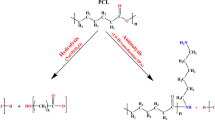Abstract
Advanced biomaterials and scaffolds for tissue engineering place high demands on materials and exceed the passive biocompatibility requirements previously considered acceptable for biomedical implants1,2,3,4. Together with degradability, the activation of specific cell–material interactions and a three-dimensional environment that mimics the extracellular matrix are core challenges and prerequisites for the organization of living cells to functional tissue5. Moreover, although bioactive signalling combined with minimization of non-specific protein adsorption is an advanced modification technique for flat surfaces6, it is usually not accomplished for three-dimensional fibrous scaffolds used in tissue engineering. Here, we present a one-step preparation of fully synthetic, bioactive and degradable extracellular matrix-mimetic scaffolds by electrospinning, using poly(D,L-lactide-co-glycolide) as the matrix polymer. Addition of a functional, amphiphilic macromolecule based on star-shaped poly(ethylene oxide) transforms current biomedically used degradable polyesters into hydrophilic fibres, which causes the suppression of non-specific protein adsorption on the fibres’ surface. The subsequent covalent attachment of cell-adhesion-mediating peptides to the hydrophilic fibres promotes specific bioactivation and enables adhesion of cells through exclusive recognition of the immobilized binding motifs. This approach permits synthetic materials to directly control cell behaviour, for example, resembling the binding of cells to fibronectin immobilized on collagen fibres in the extracellular matrix of connective tissue.
This is a preview of subscription content, access via your institution
Access options
Subscribe to this journal
Receive 12 print issues and online access
$259.00 per year
only $21.58 per issue
Buy this article
- Purchase on Springer Link
- Instant access to full article PDF
Prices may be subject to local taxes which are calculated during checkout





Similar content being viewed by others
References
Pham, Q. P., Sharma, U. & Mikos, A. G. Electrospinning of polymeric nanofibres for tissue engineering applications: A review. Tissue Eng. 12, 1197–1211 (2006).
Hutmacher, D. W. Scaffolds in tissue engineering bone and cartilage. Biomaterials 21, 2529–2543 (2000).
Ratner, B. D. & Bryant, S. J. Biomaterials: Where we have been and where we are going. Annu. Rev. Biomed. Eng. 6, 41–75 (2004).
Hollister, S. J. Porous scaffold design for tissue engineering. Nature Mater. 4, 518–524 (2005).
Stevens, M. M. & George, J. H. Exploring and engineering the cell surface interface. Science 310, 1135–1138 (2005).
Bearinger, J. P. et al. Chemisorbed poly(propylene sulphide)-based copolymers resist biomolecular interactions. Nature Mater. 2, 259–264 (2003).
Nie, Z. H. & Kumacheva, E. Patterning surfaces with functional polymers. Nature Mater. 7, 277–290 (2008).
Huang, Z-M., Zhang, Y-Z., Kotaki, M. & Ramakrishna, S. A review on polymer nanofibres by electrospinning and their applications in nanocomposites. Compos. Sci. Technol. 63, 2223–2253 (2003).
Greiner, A. & Wendorff, J. H. Electrospinning: A fascinating method for the preparation of ultrathin fibres. Angew. Chem. Int. Ed. 46, 5670–5703 (2007).
Lee, J., Cuddihy, M. J. & Kotov, N. A. Three-dimensional cell culture matrices: State of the art. Tissue Eng. B 14, 61–86 (2008).
Ma, Z. W., Gao, C. Y., Ji, J. & Shen, J. C. Protein immobilization on the surface of poly-L-lactic acid films for improvement of cellular interactions. Eur. Polym. J. 38, 2279–2284 (2002).
Steffens, G. C. M. et al. High density binding of proteins and peptides to poly(d,l-lactide) grafted with polyacrylic acid. Biomaterials 23, 3523–2531 (2002).
Ma, Z. W. et al. Surface modification of poly-L-lactide by photografting of hydrophilic polymers towards improving its hydrophilicity. J. Appl. Polym. Sci. 85, 2163–2171 (2002).
Patel, S. et al. Bioactive nanofibres: Synergistic effects of nanotopography and chemical signaling on cell guidance. Nano Lett. 7, 2122–2128 (2007).
Kim, T. G. & Park, T. G. Surface functionalized electrospun biodegradable nanofibres for immobilization of bioactive molecules. Biotechnol. Prog. 22, 1108–1113 (2006).
Dobrovolkaia, M. A. & Mcneil, S. E. Immunological properties of engineered nanomaterials. Nature Nanotechnol. 2, 469–478 (2007).
Gasteier, P. et al. Surface grafting of PEO-based star-shaped molecules for bioanalytical and biomedical applications. Macromol. Biosci. 7, 1010–1023 (2007).
Grafahrend, D. et al. Control of protein adsorption on functionalized electrospun fibres. Biotechnol. Bioeng. 101, 609–621 (2008).
Dankers, P. Y. W., Harmsen, M. C., Brouwer, L. A., Van Luyn, M. J. A. & Meijer, E. W. A modular and supramolecular approach to bioactive scaffolds for tissue engineering. Nature Mater. 4, 568–574 (2005).
Khang, G., Choee, J-H., Rhee, J. M. & Lee, H. B. Interaction of different types of cells on physicochemically treated poly(L-lactide-co-glycolide) surfaces. J. Appl. Polym. Sci. 85, 1253–1262 (2002).
Groll, J. et al. A novel star PEG derived surface coating for specific cell adhesion. J. Biomed. Mater. Res. Part A 74A, 607–617 (2005).
Hersel, U., Dahmen, C. & Kessler, H. RGD modified polymers: Biomaterials for stimulated cell adhesion and beyond. Biomaterials 24, 4385–4415 (2003).
Acknowledgements
J. Salber is acknowledged for support with the cell culture experiments. The authors want to thank M. Winnick for discussions and proofreading of the manuscript. The authors thank J. M. Baron and Y. Marquardt (Department of Dermatology and Allergology, University Hospital of the RWTH Aachen, Germany) and S. Neuß-Stein (Department of Pathology, University Hospital of the RWTH Aachen, Germany) for providing human dermal fibroblasts and human mesenchymal stem cells, respectively. This work was supported by the Deutsche Forschungsgemeinschaft (Graduiertenkolleg 1035 ‘Biointerface’).
Author information
Authors and Affiliations
Contributions
D.G., K-H.H. and J.G. conceived and designed the electrospinning approach and experiments; M.V.B. and J.G. conceived and designed the in vitro experiments. D.G., K-H.H. and P.G. carried out the electrospinning experiments and material characterization; M.V.B. carried out and analysed the in vitro experiments; G.B. conceived, carried out and analysed the in vivo experiments. D.G., K-H.H., M.V.B., G.B., M.M., P.D.D. and J.G. analysed the data; D.G., K-H.H., M.V.B., G.B., P.D.D. and J.G. contributed to writing the paper.
Corresponding author
Ethics declarations
Competing interests
The authors declare no competing financial interests.
Supplementary information
Supplementary Information
Supplementary Information (PDF 4435 kb)
Rights and permissions
About this article
Cite this article
Grafahrend, D., Heffels, KH., Beer, M. et al. Degradable polyester scaffolds with controlled surface chemistry combining minimal protein adsorption with specific bioactivation. Nature Mater 10, 67–73 (2011). https://doi.org/10.1038/nmat2904
Received:
Accepted:
Published:
Issue Date:
DOI: https://doi.org/10.1038/nmat2904
This article is cited by
-
Kidney tissue regeneration using bioactive scaffolds incorporated with differentiating extracellular vesicles and intermediate mesoderm cells
Biomaterials Research (2023)
-
Nanofibers for the Immunoregulation in Biomedical Applications
Advanced Fiber Materials (2022)
-
Conditioning the microenvironment for soft tissue regeneration in a cell free scaffold
Scientific Reports (2021)
-
Aggregation-Induced Emission Fluorescent Gels: Current Trends and Future Perspectives
Topics in Current Chemistry (2021)
-
Surface functionalization of electrospun scaffolds using recombinant human decorin attracts circulating endothelial progenitor cells
Scientific Reports (2018)



